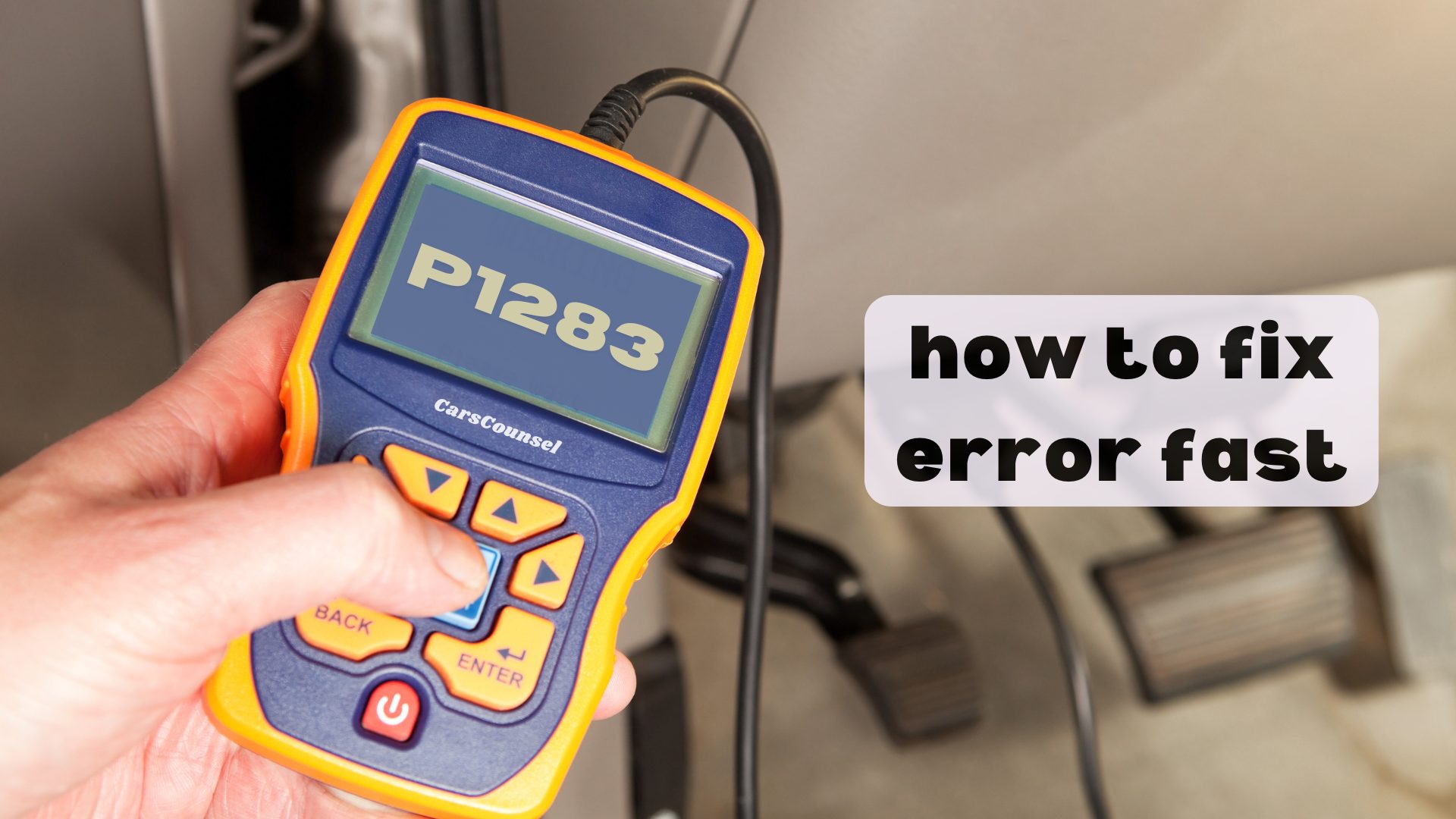If your car’s onboard computer has thrown a P1283 code, you’re likely wondering what’s going on. This code indicates an issue with the Air Fuel Ratio Sensor 1 Lean Shift Monitoring Bank 2, which plays a critical role in optimizing your engine’s performance.
A faulty sensor or vacuum leaks can trigger this error code, leading to decreased fuel efficiency, engine misfires, and poor engine performance. But what exactly is causing the problem, and how can you fix it?

Quick Navigation
Key Takeaways
- The P1283 code indicates an issue with the Air Fuel Ratio Sensor 1 Lean Shift Monitoring Bank 2, affecting engine performance and fuel efficiency.
- A faulty air-fuel ratio sensor, vacuum leaks, clogged fuel injectors, or ECU malfunction can trigger the P1283 code.
- Symptoms of a lean condition include decreased engine performance, poor fuel efficiency, engine misfires, and the Check Engine light.
- To diagnose the issue, inspect the sensor’s wiring and connections, perform sensor testing, and check for vacuum leaks and fuel quality.
- Timely repair is essential to prevent further engine damage, increased fuel consumption, and potential engine failure.
Code P1283 Description
When your vehicle’s onboard diagnostics system flags a P1283 code, it’s indicating an issue with the Air Fuel Ratio Sensor 1 Lean Shift Monitoring Bank 2.
This sensor monitors oxygen content in exhaust gases and provides feedback to the Engine Control Unit (ECU). A lean condition, which means more oxygen and less fuel, can negatively impact engine performance and fuel efficiency.
The ECU relies on accurate sensor feedback to adjust the fuel mixture for ideal combustion. Sensor reliability is vital for maintaining efficient engine operation.
If the sensor is malfunctioning, it can lead to decreased fuel efficiency, decreased engine performance, and other issues.
Causes of the P1283 Code
Frequently, the P1283 code is triggered by a combination of factors that disrupt the air-fuel ratio sensor‘s ability to provide accurate readings.
As you investigate the cause, you’ll find that a faulty air-fuel ratio sensor is often the culprit. However, it’s not the only possibility. Vacuum leaks in the intake system, clogged fuel injectors, a malfunctioning ECU, or exhaust system leaks can also contribute to the issue.
These problems can lead to a lean condition, negatively impacting your vehicle’s engine performance and fuel efficiency. It’s essential to identify and address the root cause to restore ideal engine function and prevent further damage.
Symptoms of a Lean Condition
Performance issues can be a frustrating reality when your vehicle’s engine is running in a lean condition.
You may notice a decline in engine performance, which can impact your daily commute and overall driving experience.
- You may experience decreased fuel efficiency, which can lead to higher fuel costs and increased emissions.
- Engine misfires or rough idling can cause vibrations, noise, and even stalling.
- Poor engine performance can also trigger the Check Engine light, indicating a problem that needs attention.
These symptoms can be a sign of a lean condition, which may be caused by a faulty air-fuel ratio sensor or other issues.
It’s essential to address these problems promptly to prevent further damage and maintain peak engine performance.
In this scenario, the ideal solution is to have your vehicle serviced by a qualified mechanic who can diagnose and repair any underlying issues to restore ideal engine performance.
Diagnosing the P1283 Issue
You’ve identified a P1283 code, which suggests an issue with the air-fuel ratio sensor on bank 2 of your engine. To diagnose the problem, you’ll need to investigate the sensor and related components. Start by checking the sensor’s wiring and connections for damage or corrosion. Next, perform sensor testing to determine if the sensor is providing accurate readings.
| Diagnostic Step | Description |
|---|---|
| Sensor Testing | Verify the air-fuel ratio sensor is providing accurate readings |
| Fuel Quality Check | Confirm fuel quality meets manufacturer’s specifications |
| Intake System Inspection | Inspect the intake system for vacuum leaks or blockages |
If the sensor is faulty, you may need to replace it. However, if the issue lies with fuel quality or the intake system, you’ll need to address those problems first.
Repairing the Air-Fuel Ratio Sensor
With the diagnosis complete, it’s time to repair or replace the faulty air-fuel ratio sensor, a pivotal step in resolving the P1283 code.
You’ll need to inspect the sensor and its wiring for damage or corrosion, and check for any signs of wear. Proper sensor maintenance is essential for peak fuel efficiency and engine performance.
- Clean or replace the air-fuel ratio sensor as needed
- Verify the sensor is securely connected to the engine and wiring harness
- Consult your vehicle’s repair manual for specific instructions on sensor replacement and maintenance
Additional Repairs and Costs
After addressing the air-fuel ratio sensor, your attention turns to potential additional repairs and their associated costs.
You may need to clean or replace clogged fuel injectors, which can add to the overall expense. If a vacuum leak is detected, you’ll need to repair or replace the affected components, adding to the cost.
Sensor replacement itself can range from $200 to $500, including parts and labor.
Depending on the root cause of the P1283 code, additional repairs may be necessary, increasing the total cost.
It’s essential to consult a professional mechanic for an accurate estimate, as costs can vary depending on the make and model of your vehicle.
Importance of Timely Repair
Ignoring the P1283 code can lead to further engine damage, decreased fuel efficiency, and reduced performance.
You’ll likely notice a decline in your vehicle’s overall condition, which can be costly to repair if left unchecked.
- Delaying repairs can result in:
- Increased fuel consumption, affecting your wallet and the environment
- Decreased engine power, making your vehicle less reliable
- Potential engine failure, requiring expensive overhaul or replacement
Timely repair is vital to maintaining your vehicle’s Fuel Efficiency and Engine Performance.
Consulting a Professional Mechanic
When dealing with a P1283 code, it’s essential to get expert advice to accurately diagnose and repair the issue.
You’ll want to find a mechanic you can trust, with repair experience in dealing with air-fuel ratio sensor problems. A professional mechanic will have the necessary knowledge and tools to identify the root cause of the issue and perform the necessary repairs.
They’ll be able to inspect the air-fuel ratio sensor, check for vacuum leaks, and clean or replace clogged fuel injectors. With their expertise, you can be confident that the issue will be resolved correctly, and your vehicle will be running smoothly again.
Don’t hesitate to consult a professional mechanic to get your vehicle back on the road.
More OBD-II Codes
Conclusion
You’ve been slapped with the P1283 code, and your wallet’s about to take a hit. But hey, at least you’ll have the satisfaction of watching your hard-earned cash go up in flames, along with your engine’s performance. Don’t bother trying to diagnose it yourself; you’ll just end up making things worse. Instead, fork over the cash to a pro and hope they can fix it before your engine turns into a pricey paperweight.

